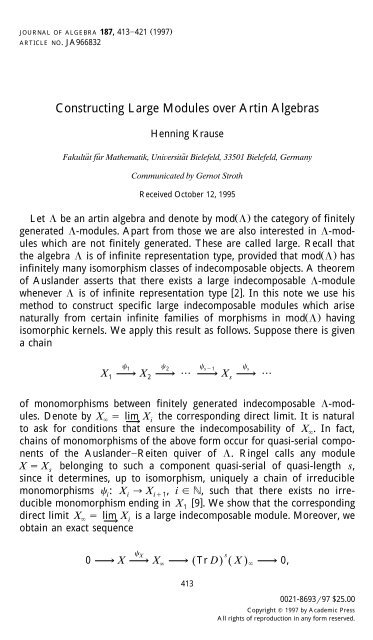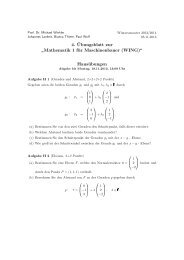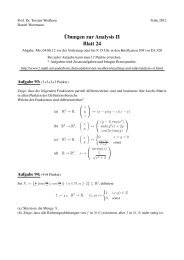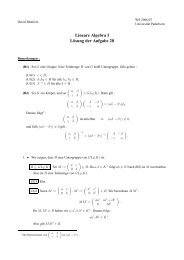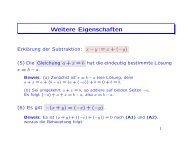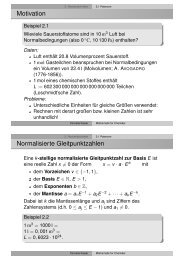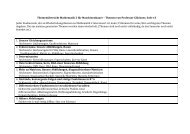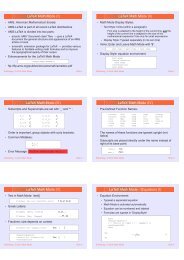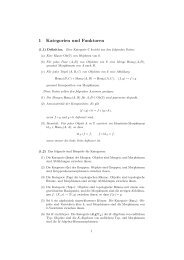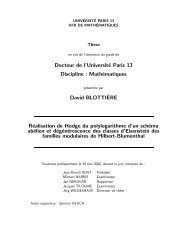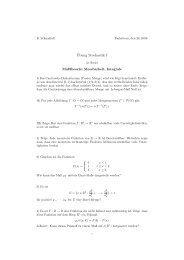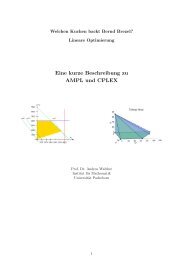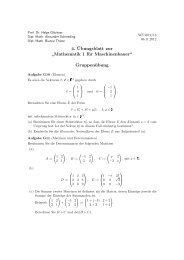Constructing Large Modules over Artin Algebras
Constructing Large Modules over Artin Algebras
Constructing Large Modules over Artin Algebras
You also want an ePaper? Increase the reach of your titles
YUMPU automatically turns print PDFs into web optimized ePapers that Google loves.
Ž .<br />
JOURNAL OF ALGEBRA 187, 413421 1997<br />
ARTICLE NO. JA966832<br />
<strong>Constructing</strong> <strong>Large</strong> <strong>Modules</strong> <strong>over</strong> <strong>Artin</strong> <strong>Algebras</strong><br />
Henning Krause<br />
Fakultat ¨ fur ¨ Mathematik, Uniersitat ¨ Bielefeld, 33501 Bielefeld, Germany<br />
Communicated by Gernot Stroth<br />
Received October 12, 1995<br />
Let be an artin algebra and denote by modŽ .<br />
the category of finitely<br />
generated -modules. Apart from those we are also interested in -modules<br />
which are not finitely generated. These are called large. Recall that<br />
the algebra is of infinite representation type, provided that modŽ .<br />
has<br />
infinitely many isomorphism classes of indecomposable objects. A theorem<br />
of Auslander asserts that there exists a large indecomposable -module<br />
whenever is of infinite representation type 2 . In this note we use his<br />
method to construct specific large indecomposable modules which arise<br />
naturally from certain infinite families of morphisms in modŽ .<br />
having<br />
isomorphic kernels. We apply this result as follows. Suppose there is given<br />
a chain<br />
<br />
1 2 s1 s<br />
X1 X2 Xs<br />
<br />
<br />
<br />
<br />
<br />
of monomorphisms between finitely generated indecomposable -modules.<br />
Denote by X<br />
lim Xi<br />
the corresponding direct limit. It is natural<br />
to ask for conditions that ensure the indecomposability of X . In fact,<br />
chains of monomorphisms of the above form occur for quasi-serial components<br />
of the AuslanderReiten quiver of . Ringel calls any module<br />
X Xs<br />
belonging to such a component quasi-serial of quasi-length s,<br />
since it determines, up to isomorphism, uniquely a chain of irreducible<br />
monomorphisms i: Xi X i1, i , such that there exists no irre-<br />
ducible monomorphism ending in X <br />
1 9 . We show that the corresponding<br />
direct limit X<br />
lim Xi<br />
is a large indecomposable module. More<strong>over</strong>, we<br />
obtain an exact sequence<br />
<br />
<br />
<br />
X<br />
s<br />
0 X X Tr D X 0,<br />
<br />
<br />
<br />
<br />
413Ž . Ž . <br />
<br />
0021-869397 $25.00<br />
Copyright 1997 by Academic Press<br />
All rights of reproduction in any form reserved.
414<br />
HENNING KRAUSE<br />
where Ž Tr D. s Ž X.<br />
denotes the sth power of the transpose of the dual of X<br />
which is again a quasi-serial module. This exact sequence has the following<br />
property. Every morphism : X Y in modŽ .<br />
belongs to the infinite<br />
radical of modŽ .<br />
if and only if factors through X , and more<strong>over</strong>, <br />
induces a commutative diagram of the form<br />
<br />
X<br />
<br />
Ž .<br />
sŽ .<br />
<br />
0 X X Tr D X 0<br />
<br />
<br />
<br />
<br />
<br />
<br />
<br />
0 Y<br />
Y<br />
Y Ž .<br />
t<br />
<br />
Ž .<br />
<br />
<br />
<br />
<br />
Tr D Y 0<br />
provided that Y is quasi-serial of quasi-length t.<br />
We would like to point out as an application that modules of the form<br />
X<br />
can be used to construct generic modules in the sense of Crawley-<br />
Boevey 5 ; we refer the reader to 8 . Note that the existence of a generic<br />
module is crucial for the validity of the second BrauerThrall conjecture<br />
for artin algebras 5 .<br />
<br />
THE CONSTRUCTION<br />
Let be an artin algebra and denote by ModŽ .<br />
the category of right<br />
-modules. Given two morphism : X Y , i 1, 2, in ModŽ .<br />
i<br />
i<br />
we<br />
define 2 1 if there exists a morphism : Y1 Y2 such that 2<br />
1. We write 2 1 if 2 1 and 1 2. Recall that a morphism<br />
: XY in modŽ .<br />
is irreducible, provided that is neither a split<br />
monomorphism nor a split epimorphism and if for any factorization<br />
in modŽ .<br />
2 1 either 1 is a split monomorphism or 2<br />
is a split<br />
epimorphism.<br />
<br />
i<br />
<br />
i<br />
THEOREM 1. Let 0 X Yi Zi 0, i , be a family of exact<br />
sequences in modŽ .. Suppose that i is irreducible and that i1 i<br />
for<br />
all i . Then there exists a family of morphisms i: Yi Yi1<br />
satisfying<br />
i1 ii for all i such that Y lim Yi<br />
is a large denumerably<br />
generated indecomposable module.<br />
We postpone a proof and discuss some preliminaries. We shall use the<br />
category ŽmodŽ ., Ab. of additive functors from modŽ .<br />
to the category<br />
Ab of abelian groups. Note that for a pair of morphisms i: X Y i,<br />
i 1, 2, in modŽ . we have iff ImŽHom Ž , ..<br />
2 1 2 <br />
ImŽHom Ž , .. as subfunctors of Hom Ž X, .<br />
1 . We shall also use the fully<br />
faithful functor<br />
<br />
ModŽ . Ž modŽ op .,Ab., XX<br />
,
LARGE MODULES 415<br />
which identifies the pure-injective -modules with the injective objects in<br />
Ž Ž<br />
op<br />
mod ., Ab .. Note that Ext 1<br />
Ž , X .<br />
vanishes on finitely presented<br />
functors for every -module X. More<strong>over</strong>, every finitely generated -<br />
module is automatically pure-injective. The following characterization of<br />
an irreducible morphism in modŽ .<br />
is needed.<br />
LEMMA 2. For a nonsplit exact sequence 0 X Y Z 0 in<br />
modŽ .<br />
the following are equialent:<br />
Ž. 1 is irreducible.<br />
Ž. 2 or for each morphism : X Y in modŽ ..<br />
Ž. 3 or for each morphism : X Y in ModŽ ..<br />
Proof. Ž. 1 Ž. 2 See 3, Proposition 2.7 .<br />
Ž. 23 Ž. One direction is trivial. Therefore suppose Ž. 2 . We apply the<br />
Ž Ž . . Ž Ž<br />
op<br />
well-known duality fp mod ,Ab fp mod ., Ab.<br />
between the categories<br />
of finitely presented functors which sends Hom Ž X, .<br />
to X<br />
Že.g., see . 6 . It follows from this duality that Ž 2.<br />
is equivalent to the<br />
Ž Ž<br />
op<br />
property that any subobject G of X in mod ., Ab.<br />
<br />
either contains<br />
or is contained in F KerŽ .. Taking G KerŽ .<br />
<br />
for a<br />
morphism : X Y we obtain either a morphism Y <br />
<br />
Y if F G since Ext 1<br />
Ž Z , Y .<br />
0, or we obtain a<br />
morphism Y Y if G F since Ext 1<br />
Ž , Y .<br />
0. Thus<br />
we have or .<br />
Let C be an abelian category and F: C Ab be an additive functor. A<br />
nonzero element x FŽ X.<br />
is called minimal if for each : X Y in C<br />
the property FŽ .Ž x.<br />
0 implies that is a monomorphism. The following<br />
facts are easily verified.<br />
LEMMA 3. Ž. 1 If x FŽ X . is minimal, then X is indecomposable.<br />
Ž. 2 If X is a noetherian object in C and x FŽ X . is a nonzero element,<br />
then there exists an epimorphism : X Y such that FŽ .Ž x. FY Ž . is<br />
minimal.<br />
Proof. See 1, Lemma 3.2 .<br />
Proof of Theorem 1. Let F Hom Ž X, . ImŽHom Ž , ..<br />
i i and<br />
denote by : Hom Ž X, . F the canonical morphism in ŽmodŽ .,Ab.<br />
<br />
.<br />
Using the preceding lemmas one constructs easily a family of morphisms<br />
i: X W i, i , together with a family of natural numbers 1 n0 n1
416<br />
HENNING KRAUSE<br />
n such that<br />
2<br />
Ž. i Ž . FW Ž . is minimal for all i ;<br />
i<br />
i<br />
Ž ii.<br />
for all i .<br />
ni<br />
i ni1<br />
Ž .<br />
Applying ii we obtain the following chain of morphisms.<br />
<br />
1 n12 n1 n22<br />
1 n11 1 n1 n21 2<br />
Y Y W Y Y W<br />
<br />
<br />
n2<br />
<br />
Y .<br />
n 2<br />
<br />
<br />
<br />
<br />
<br />
<br />
Taking the corresponding compositions in this chain we obtain morphisms<br />
: Y Y and : W W , i , such that<br />
i i i1 i i i1<br />
Ž iii.<br />
i1 ii and i1 ii<br />
for all i ;<br />
Ž iv.<br />
Y lim Y and W lim W are isomorphic.<br />
i<br />
<br />
i<br />
<br />
To show that Y is indecomposable we extend the functor F: modŽ .<br />
Ab<br />
to a functor F: ModŽ .<br />
Ab which commutes with direct limits and<br />
denote by : Hom Ž X, .<br />
F the corresponding morphism between<br />
functors from ModŽ . to Ab. Using Ž i.<br />
it is not hard to check that the<br />
morphism lim has the property that Ž . FŽ W .<br />
i<br />
is minimal.<br />
We refer to the proof of 2, Theorem 1.5<br />
for details and conclude that Y<br />
is indecomposable.<br />
<br />
Our next aim is to discuss some properties of the morphism <br />
lim i: X Y which arises in Theorem 1. We will use the following<br />
general fact.<br />
<br />
PROPOSITION 4. Let i: X Y i, i I, be a directed family of morphisms<br />
in ModŽ .<br />
and denote by lim i: X Y its direct limit. Suppose also<br />
that Y ModŽ .<br />
is pure-injectie. Then a morphism : X Y factors<br />
through if and only if factors through i<br />
for all i I.<br />
<br />
Proof. One direction is clear. Therefore suppose that factors through<br />
i<br />
for all i I. We obtain for each i an exact commutative diagram<br />
0 F X Y <br />
<br />
<br />
<br />
i i <br />
<br />
0 G X Y
LARGE MODULES 417<br />
and therefore also an exact commutative diagram<br />
0 limF X Y <br />
<br />
<br />
<br />
<br />
i <br />
<br />
<br />
0 G X Y <br />
<br />
<br />
<br />
<br />
<br />
Ž Ž<br />
op<br />
since direct limits in mod ., Ab.<br />
are exact. Using the injectivity of<br />
Y there exists a morphism Y Y <br />
making the above<br />
diagram commutative. Thus the assertion follows.<br />
<br />
i<br />
<br />
i<br />
COROLLARY 5. Let 0 X Yi Zi 0, i I, be a directed family of<br />
exact sequences in modŽ .<br />
and suppose that i<br />
is irreducible for all i I.<br />
Suppose also that : X Y is a morphism in ModŽ ., where Y is<br />
pure-injectie. Then the direct limit lim i: X Y has the following<br />
properties:<br />
Ž. 1 factors through if and only if factors through i<br />
for all i I.<br />
Ž. 2 Either factors through or factors through .<br />
<br />
Proof. Combine Proposition 4 and Lemma 2.<br />
QUASI-SERIAL MODULES<br />
Families of irreducible epimorphisms having isomorphic kernels arise<br />
quite often for artin algebras of infinite representation type. In fact one<br />
may ask whether any artin algebra of infinite representation type admits<br />
such a family. We devote the second half of this paper to a class of finitely<br />
generated modules where such families naturally occur. To this end recall<br />
the following concept which was introduced in 8 . A component C of the<br />
AuslanderReiten quiver of is called quasi-serial if<br />
Ž. i C contains neither projective nor injective modules;<br />
Ž .<br />
k<br />
ii if 0 X i1Yi<br />
Z 0 is an almost split sequence of<br />
modules in C, then k 2 and k 2 with lY Ž . lY Ž .<br />
1 2 implies that<br />
lY Ž . lŽ X. lY Ž ..<br />
1 2<br />
Examples of such components are the regular components <strong>over</strong> a hereditary<br />
artin algebra. An indecomposable module X belonging to a quasiserial<br />
component is called quasi-serial, and X is quasi-simple if there exists<br />
no irreducible monomorphism ending in X. We shall use the following<br />
properties of a quasi-serial module.
418<br />
HENNING KRAUSE<br />
Ž X .<br />
LEMMA 6.<br />
i i<br />
Ž.<br />
To each quasi-serial module X corresponds a unique family<br />
of indecomposables such that<br />
1 X1 is quasi-simple and X Xs<br />
for some s ;<br />
Ž. 2 there exists an irreducible monomorphism i: Xi Xi1<br />
for all<br />
i.<br />
Proof. See 8 .<br />
The number s with X Xs<br />
is called the quasi-length of X and it is<br />
convenient to put X0<br />
0.<br />
LEMMA 7. Let X be a quasi-serial module of quasi-length s and let<br />
s1 i<br />
0 i s. Then there is an exact sequence 0 Xi<br />
Xs<br />
Ž Tr D. i Ž X .<br />
si 0. If 1 i s, then the induced morphism<br />
: X Tr DŽ X . is irreducible.<br />
s s s1<br />
Proof. Straightforward.<br />
Each quasi-simple module determines uniquely a large indecomposable<br />
module in the following sense.<br />
THEOREM 8.<br />
<br />
Let X be a quasi-simple module. Then there exists a chain<br />
<br />
1 2<br />
XX1 X2<br />
<br />
<br />
of irreducible monomorphisms such that each Xi<br />
is indecomposable and X<br />
lim Xi<br />
is a large denumerably generated indecomposable module. The<br />
module X<br />
depends, up to isomorphism, only on X. If Y is a second<br />
quasi-simple module, then Y X<br />
if and only if Y X.<br />
<br />
<br />
<br />
<br />
<br />
1 2<br />
Proof. The existence of a chain X X1 X2 of irreducible<br />
monomorphisms follows from Lemma 6. For each i 1 define i <br />
i<br />
i<br />
. We obtain a family 0 X X Tr DŽ X .<br />
i1 1 i i1 0 of ex-<br />
act sequences where i<br />
is irreducible for all i by Lemma 7. Thus the<br />
existence of a large denumerably generated indecomposable module X <br />
lim Xi<br />
follows from Theorem 1 and it remains to show its uniqueness.<br />
First one observes that the X i’s are uniquely determined by X and that<br />
<br />
any morphism : X X satisfying i i i1 i1 i i<br />
is irreducible. The<br />
latter guarantees that the module lim X constructed in Theorem 1 is<br />
actually a limit where each morphism Xi Xi1<br />
is irreducible. Now<br />
assume an arbitrary choice of irreducible morphisms : X X .It<br />
<br />
<br />
i<br />
i i i1<br />
follows from 8, 4.1<br />
that there exist isomorphisms i: Xi Xi<br />
satisfying<br />
<br />
i1ii i for all i. Taking direct limits the morphism lim i<br />
gives an isomorphism between lim X i taken <strong>over</strong> the i’s and lim Xi<br />
taken <strong>over</strong> the i ’s. Finally suppose that Y is a second quasi-simple such<br />
that Y X . The morphism lim : X X composed with the<br />
i <br />
isomorphism X Y factors through some Yj<br />
since X is finitely generated.<br />
We denote the corresponding morphism by : X Y j.<br />
It is not hard
LARGE MODULES 419<br />
to check that there exists an isomorphism : Xj Yj such that j<br />
and therefore X Y.<br />
Let C be the center of the artin algebra and denote by I an injective<br />
envelope of CradŽ C .. Using the functor D Hom Ž , I .<br />
C between<br />
Ž . Ž<br />
op<br />
Mod and Mod . which induces a duality between modŽ .<br />
and<br />
Ž<br />
op<br />
mod . we obtain the following consequence of Theorem 8.<br />
COROLLARY 9.<br />
Let X be a quasi-simple module. Then there exists a chain<br />
2 <br />
2 1<br />
1<br />
X X X<br />
<br />
of irreducible epimorphisms such that each X i is indecomposable and X <br />
i<br />
lim X is a large module which depends, up to isomorphism, only on X.<br />
<br />
op<br />
Proof. The -module Y DŽ X.<br />
is quasi-simple and admits a chain<br />
<br />
<br />
1 2<br />
YY1Y2 of irreducible monomorphisms. Applying D we obtain<br />
DŽ 2. DŽ 1.<br />
a chain DY Ž . DY Ž .<br />
2 1 X of irreducible epimorphisms<br />
<br />
with X lim DY Ž . DŽ lim Y . DY Ž ..<br />
<br />
<br />
<br />
<br />
<br />
i i <br />
Remark 10. In 8 , it is shown that the module X<br />
is -pure-injective<br />
Ž . n Ž .<br />
<br />
provided that Tr D X X for some n . Of course, the module X<br />
Ž .<br />
op<br />
is pure-injective since it is of the form DY for some -module Y. We<br />
do not know of any example where the module X decomposes.<br />
Let X be a quasi-serial module of quasi-length s and fix a chain X <br />
<br />
<br />
s s1 <br />
Xs Xs1 of irreducible monomorphisms such that Xi<br />
is inde-<br />
composable for all i s. We denote by X: X lim Xi X<br />
the induced<br />
monomorphism. The module X<br />
depends only on X according to Lemma<br />
6 and Theorem 8. More<strong>over</strong>, the morphism X<br />
is unique in the sense that<br />
for any different choice of irreducible monomorphisms<br />
i: Xi X i1, i s, there exists an isomorphism : X X<br />
with<br />
. Finally note that induces an exact sequence<br />
X X X<br />
<br />
<br />
X<br />
s<br />
0 X X Ž Tr D. Ž X. 0.<br />
<br />
<br />
<br />
This follows from Lemma 7. Analogously, there is an induced epimorphism<br />
X i<br />
: X X for X lim X which is part of an exact sequence<br />
<br />
<br />
s <br />
<br />
X<br />
<br />
<br />
0 Ž D Tr. Ž X.<br />
X X 0.<br />
We proceed with a discussion of the morphisms X<br />
and X . For each<br />
n and each pair of modules X, Y in modŽ . we denote by rad n<br />
Ž X, Y .<br />
the morphisms in Hom Ž X, Y .<br />
which belong to the nth power of the<br />
Jacobson radical of mod Ž . . As usual rad <br />
Ž X, Y . rad n<br />
Ž X, Y .<br />
n <br />
.<br />
Using the above notation we have the following lemma.
420<br />
HENNING KRAUSE<br />
LEMMA 11. Let X Xs<br />
be a quasi-serial module and Y be indecompos-<br />
able. If rad n<br />
Ž X, Y . and n s, then there exists a morphism <br />
ns<br />
rad Ž X , Y . such that .<br />
s1<br />
<br />
s<br />
Proof. First suppose that n s. For each i, 0is, there is an exact<br />
<br />
s1 i i<br />
Ž .<br />
i<br />
sequence 0 X XZ 0 with Z Tr D Ž X .<br />
i i i si accord-<br />
ing to Lemma 7. Let i be maximal such that there are morphisms<br />
: Xs1 Y and : Zi Y with s i. The assertion<br />
follows if i s since 0. Therefore assume that i s. Using the<br />
s<br />
Ž .<br />
i1<br />
orem 13.3 and Hom X , Z rad Ž X , Z .<br />
s1 i s1 i . This contradiction<br />
finishes the first part of our proof. Now suppose that n s. There are<br />
morphisms : X Y and radŽ Y , Y .<br />
i i i i i1 for each i such that<br />
ImŽHom Ž , .. rad i<br />
Ž X, . and for all i <br />
i i1 i i<br />
4, V,<br />
Lemma 7.10 . Using the first part we find a morphism 0: Xs1 Ys<br />
such<br />
that s 0 s. Thus n n 1 s 0 s<br />
with<br />
ns<br />
rad Ž X , Y . and the proof is complete.<br />
n1 s 0 s1 n<br />
We are now in position to prove the following property of the morphism<br />
X : X X .<br />
THEOREM 12. Let : X Y be a morphism between finitely generated<br />
indecomposable modules and suppose that X is quasi-serial.<br />
Ž. 1 rad <br />
Ž X, Y . if and only if there exists a morphism : X<br />
Y<br />
such that X .<br />
Ž. 2 If rad <br />
Ž X, Y ., then there exists a morphism : X Y<br />
such<br />
that Y X.<br />
Proof. Ž. 1 The inclusion ImŽHom Ž , Y .. rad <br />
Ž X, Y .<br />
X<br />
is obvious<br />
from the definition of . Therefore let rad <br />
Ž X, Y .. We fix a chain<br />
<br />
<br />
1 2<br />
X<br />
X1X2 of irreducible monomorphisms with X1<br />
quasi-simple and<br />
XXs<br />
for some s . It follows from the previous lemma that for all<br />
i any morphism rad <br />
Ž X , Y .<br />
i<br />
i can be extended to a morphism<br />
rad <br />
Ž X , Y .<br />
i1 i1 such that i i1 i. Here one uses the fact that<br />
rad <br />
Ž X , Y . rad n<br />
Ž X , Y .<br />
i1 i1 for some n . Taking s<br />
we obtain<br />
a morphism lim i<br />
which has the desired property.<br />
Ž. 2 Similar to Ž. 1 .<br />
Using again the functor D Hom Ž , I .<br />
C we obtain the analogous<br />
property of the morphism X : X X.<br />
<br />
COROLLARY 13. Let : Y X be a morphism between finitely generated<br />
indecomposable modules and suppose that X is quasi-serial.<br />
property of the almost split sequence starting in Zi<br />
we deduce that is an<br />
i1<br />
Ž .<br />
i1<br />
isomorphism. Thus rad X, Y since rad Ž X, Z . by 7, Thei<br />
i
LARGE MODULES 421<br />
Ž. 1 rad <br />
Ž Y, X . if and only if there exists a morphism : Y X <br />
such that X .<br />
Ž. <br />
Ž .<br />
<br />
2 If rad Y, X , then there exists a morphism : Y X such<br />
that Y X .<br />
REFERENCES<br />
1. M. Auslander, Representation theory of artin algebras II, Comm. Algebra 1 Ž 1974 .,<br />
269310.<br />
2. M. Auslander, <strong>Large</strong> modules <strong>over</strong> artin algebras, in ‘‘Algebra, Topology and Categories,’’<br />
Academic Press, New YorkLondon, 1976.<br />
3. M. Auslander and I. Reiten, Representation theory of artin algebras IV, Comm. Algebra 5<br />
Ž 1977 ., 443518.<br />
4. M. Auslander, I. Reiten, and S. Smalø, ‘‘Representation Theory of <strong>Artin</strong> <strong>Algebras</strong>,’’<br />
Cambridge Univ. Press, Cambridge, 1995.<br />
5. W. Crawley-Boevey, <strong>Modules</strong> of finite endolength <strong>over</strong> their endomorphism ring, in<br />
‘‘Representations of <strong>Algebras</strong> and Related Topics,’’ Ž S. Brenner and H. Tachikawa, Eds. .<br />
London Math. Soc. Lect. Note Series, Vol. 168 pp. 127184, Cambridge Univ. Press,<br />
Cambridge, 1992.<br />
6. L. Gruson, Simple coherent functors, in ‘‘Representations of <strong>Algebras</strong>,’’ Lecture Notes in<br />
Math. Vol. 488, pp. 156159, Springer-Verlag, New YorkBerlin, 1975.<br />
7. K. Igusa and G. Todorov, A characterization of finite AuslanderReiten quivers, J.<br />
Algebra 89 Ž 1984 ., 148177.<br />
8. H. Krause, Generic modules <strong>over</strong> <strong>Artin</strong> algebras, Proc. London Math. Soc., to appear.<br />
9. C. M. Ringel, Finite dimensional hereditary algebras of wild representation type, Math. Z.<br />
161 Ž 1978 ., 235255.


